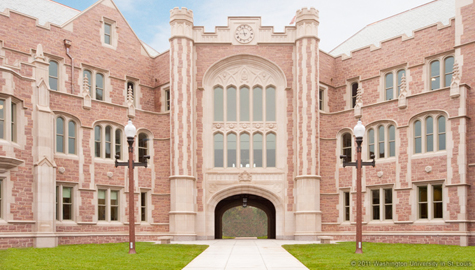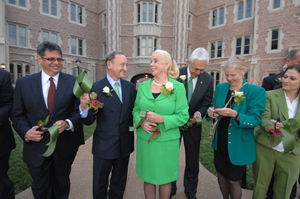
David Kilper
The northeast-facing facade of Preston M. Green Hall provides a gateway to the university at the intersection of Skinker Blvd. and Forest Park Parkway.
A dedication ceremony for Preston M. Green Hall, a new engineering building on the Danforth Campus of Washington University in St. Louis, was held Sept. 23. The keynote speaker at the dedication was Charles M. Vest, PhD, president of the National Academy of Engineering and president emeritus of the Massachusetts Institute of Technology.
Also speaking was Stephen F. Brauer, chair of Washington University’s Board of Trustees; Chancellor Mark S. Wrighton; Ralph S. Quatrano, PhD, dean of the School of Engineering & Applied Science and the Spencer T. Olin Professor; Danielle Hoover, a WUSTL senior majoring in systems science & engineering; and Nancy Green, Preston Green’s widow.
Green Hall, the third building in a new engineering complex at WUSTL, is home to the Preston M. Green Department of Electrical & Systems Engineering, the second oldest electrical engineering department in the country, and the headquarters for the International Center for Advanced Renewable Energy & Sustainability (I-CARES), a center that coordinates university-wide activities that cannot be done by single investigators or by single disciplines alone in the areas of energy, environment and sustainability.
Green Hall also includes space for the Department of Energy, Environmental & Chemical Engineering.

Joe Angeles
Seconds after cutting the ribbon at the dedication of Green Hall, Chancellor Mark S. Wrighton and Nancy Green share a smile.
“Preston M. Green Hall is more than a magnificent new facility,” Wrighton said at the dedication. “Generations of outstanding students will be educated and contribute to the discovery of new engineering knowledge in the classrooms and laboratories of Green Hall.
“As a gathering place for scholars dedicated to bringing benefit to humankind through new technologies, Green Hall represents a commitment to addressing the world’s most pressing challenges,” he said.
The 83,849-square-foot building, designed by the architectural firm RMJM and constructed by Clayco, is located at the northeast corner of the Danforth Campus. An archway diagonal to the intersection of Skinker Blvd. and Forest Park Parkway echoes architecturally the archway of the university’s signature building, Brookings Hall, providing a dramatic entrance to the campus.
Construction of Green Hall began in April 2010 and finished last month in time for classes that began Aug. 30.
Green Hall includes three classrooms and was designed for 17 laboratories, with research already under way that includes medical and energy applications. For example, electrical engineering faculty and students are working on next-generation non-invasive imaging techniques that could allow for better understanding of brain function and the ability to identify patients at risk for heart attacks more quickly and accurately. Electrical engineers also are working on smart-grid efficiency and energy storage.
Systems science and engineering faculty and students are using mathematical methods to improve radiation therapy and model carbon-cycle feedbacks to understand global climate change. With physical connections to the engineering school’s departments of Biomedical Engineering and Energy, Environmental & Chemical Engineering, researchers and students will be able to collaborate more efficiently.
“As part of the new engineering complex, Green Hall not only links and integrates multiple disciplines within the School of Engineering & Applied Science,” Quatrano said, “but its location just steps away from the Skinker Metrolink station provides a direct connection to the Washington University School of Medicine. These connections and other connections with the physical sciences are critical for the implementation of the research foci in our school’s strategic plan.”
Vest listed important innovations of our time that have come primarily, and in some cases exclusively, from our research universities: computing, the laser, the Internet, numerically controlled machinery, the fundamentals of the GPS system, the deployment of the World Wide Web, the genomic revolution and most of modern medicine.
“My point,” Vest said, “and the one point I’d like you to remember if you take nothing else away, is that this is serious business in which we are engaged. I don’t think there’s a job in America that is not based on utilizing one or more of these innovations that have stemmed from our research universities.”
He went on to list challenges engineering faces in a changing world, including the precipitous decline of American students taking engineering degrees, but went on to say that “this is without question the most exciting era in human history to be engaged in science and engineering” and that if “you really want to make the world a better place, there’s no better pathway through which to do it.”
Green is more than just the name of the building; like all of WUSTL’s recent construction projects, the hall was designed to meet LEED specifications for a Gold rating. LEED, the acronym for Leadership in Energy and Environmental Design, is a nationally accepted rating system for the design, construction and operation of buildings that use its specifications for achieving environmental sustainability.
Sustainable features include: more than 50 percent of the building’s wood products came from sustainably managed forests; more than 90 percent of the construction waste was diverted from landfill; and 100 percent of irrigation is provided by captured rainwater stored in a turn-of-the-century brick sewer converted to a cistern.
Preston M. Green
The building is named in honor of the late Preston M. Green, an alumnus and benefactor of Washington University. In 2006, Chancellor Wrighton announced an $8 million commitment from the estate of Preston Green to support the School of Engineering & Applied Science and its Department of Electrical & Systems Engineering, which is also named in Green’s honor.
In 2010, the Preston M. Green Charitable Foundation committed an additional $5 million to support the construction of the Preston M. Green Hall, bringing the total support to $13 million.
“It is a privilege to have the opportunity to honor our distinguished alumnus Preston M. Green,” Wrighton said. “This building will be a lasting tribute to a longtime friend and benefactor.”
Born in 1915 in St. Louis, Green earned a bachelor of science degree in electrical engineering from Washington University in 1936. After graduation, Green worked in a local factory until he joined Southwest Steel Supply Co. in 1950 as vice president of purchasing and production.
He became president in 1955 and chairman of the board in 1957. During his career at Southwest Steel Supply Co., Green was responsible for adding a second manufacturing plant in Madison, Ill., and growing his company into the leading processor of steel throughout the Midwest.
Green designed most of the equipment used by Southwest Steel Supply Co. and was acknowledged for creating more efficient processing procedures. He was recognized nationally for his leadership and vision within the steel industry, including receiving the Steel Distributor of the Year award in 1986 from the Association of Steel Distributors.
In 1990, Green sold Southwest Steel to Hanwa American, a subsidiary of the Hanwa Corp. of Japan. Green died in 2003, but his legacy continues today through his many contributions, both professional and philanthropic, and through the work of his widow, Nancy Green, who lives in St. Louis and serves on the advisory board for the Preston M. Green Charitable Foundation.
“I wish Preston could be here today to see his dream become reality,” Nancy Green said. “He was a strong believer in innovation and forward thinking. Preston would have been so very proud of the School of Engineering & Applied Science and the facilities that it is providing for its students.”
The future of engineering education and research
Held in conjunction with the dedication of Green Hall, Washington University hosted a symposium “Opportunities and Challenges in Engineering Education & Research,” which featured the National Science Foundation Director Subra Suresh, DSc; Dennis Muilenburg, president and chief executive officer of Boeing Defense, Space & Security and a member of WUSTL’s Board of Trustees; and P.R. Kumar, DSc, professor and College of Engineering chair in computer engineering at Texas A&M University and a WUSTL alumnus.
The speakers addressed national science and engineering policy in a time of retrenchment and highlighted the work ongoing at Washington University, including in Green Hall. The speakers’ remarks and the questions and answers that followed can be viewed online at engineering.wustl.edu/symposium.